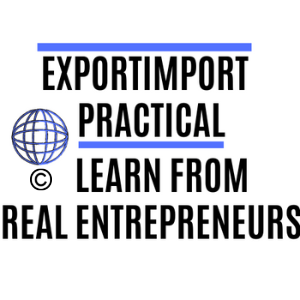If you intend to start or run an import-export business by yourself, you must plan your business. A good export-import business plan will not only determine the success of your business but also helps you maintain focus after success.
Making an export-import business plan is not as difficult as you think. It includes 2 main phases. To make a completed plan, first, you need to know the industry in which you are involved, this means comprehensive research, analyze and conclusions making.
Secondly, you need to determine what to accomplish with your plan (goals) and how you will execute that plan. Finally, you should draft an export-import business plan that is concise, complete, and comprehensive.
We will explore in detail, the step by step planning process below. But first, we will learn what an export-import business plan is and why do we need it in our export-import business.
1. What is an export-import business plan

A business plan is an important management tool for export-import companies, managers and entrepreneurs. It includes all information, strategies, and tactics for achieving the company goals.
It gives the business a clear orientation on import and export business activities and shows where to put efforts to. Export-import business plan can be created after doing the research and analysis of the industry, competitors, customers, juridical environment, political environment, and other aspects that directly or indirectly have an effect on your business.
Even if you have a small export-import business or you operate as an export-import agent, you should also have your own plan.
So why do you need an export-import business plan?
The export-import business plan helps you make the right decisions in your business and helps you quickly grasp the overall process. It gives you goals and directions, where you are going.
It will save you time and money. Business plan has been done, based on the previous analysis of the relevant factors and conditions, this ensures, the decisions you make in your business are optimal. Those, who are making decisions blindly are risking to make costly mistakes.
A business plan for export-import business can be an important tool, to get you financing. Sometimes investors, partners and potential clients will assess the quality of your business through a complete plan, so it’s important to seriously develop a smart, perfect plan.
Analyze is always part of the business planning. Sometimes, doing the analysis for your planned export-import business can turn out, that the originally planned business idea is economically not viable. In this case, a business plan or planning process can save you from future possible losses.
To make a complete plan, let’s first learn about the content of the export-import business plan.
2. The content of the export-import business plan

1. Project summary
The project summary can act as an independent document, including the highlights of your business plan. In fact, many investors only ask to see a project summary when they are evaluating your business.
In the business plan summary, only the most important elements should be highlighted. Such as company main purpose/mission, main activities, products, projected financial goals and figures, including the investment needs. Also, the main competitive advantage and UPS (unique selling point) should be pointed out there.
TIP: In the summary, at the top of the page, right below your export- import business name, write a sentence about your business. The sentence about what business you are going to do. This can be a slogan or sentence that summarizes the export- import business activities and goals of what you are planning to achieve.
NB! The summary of the export/import business plan should be made as the last part!
2. Company introduction

In this section, you present the information such as business registration information, export-import business name, business structure, organogram, types of licenses, the address of the office (including rent information and equipment), website address, and social media channels, etc.
Also, it is important (for investors especially) to have information about the founder(s) and key persons in the company. In your export import business plan, you can include the CV,s of the key persons.
3. Products and services description

The export-import business is a product-centric business. That’s why this is the core part of a business. You need to mention exactly what products and/or services you are going to import and/or export or otherwise deal with.
Product descriptions should include
- Product specification and the description of its usages.
- What is special about your product or service.
W hichare the differences and unique selling points compared to the competitor’s products in the market?- The selling prices on the market, which you are targeting and how these will be in the next 5 years.
- What are the purchasing or manufacturing prices for these products and how these will be in the next 5 years?
- Predictions for supply and demand relationship in the future.
- Other aspects, factors regarding your products ( example the quality standards).
4. Marketing plan

This is a very important part of the export – import business plan. Probably most important, as it will generate sales for your exim business.
If you are working with a team, the marketing plan will help clarify the goals and common points.
When you have a specific product, you need to plan marketing, promotion, distribution, shipping method, and sales to draw customers for that product.
The import export business marketing plan will be about the activities, which will help to sell products to domestic and oversea markets
Which channels will you use to boost your product sales? You have to describe, how to adapt your product to each market-specific demand. How to reach potential clients? What is the competitive advantage, you are pointing out when marketing your product(s)?
Read also: How to find international buyers for your goods.
5. Analyze the market and competitors

This part and the conclusions you are getting out from here will be a foundation for your export-import business marketing plan. A comprehensive analysis of the market, industry, competitors is needed, including also not-direct stakeholders in the export- import industry, which includes regulators and government.
This section will help you understand all the surrounding elements: the market you are targeting, the target country, your target audience, your competitors, before starting exporting/importing the products.
6. Financial draft
Point out the outstanding aspects of your financial plan, including a chart that shows your expected revenue, expenses and profits and investment needs. What is your next 5-year investment plan (where you will invest), what government fees are required, when they are spent, when they are collected, etc. All this information should be included in a financial plan.
You can also use this part, to explain more about your export-import business model to your clients, partners or investors, if there is a need.
When estimating the growth of your export-import business, your assumptions should be based on comprehensive industry research, combined with a competitive situation analyze. Very important is to analyze and bring out, how quickly your export/import business can produce positive cash flow and when you will reach the break-even point.
If you have difficulty drafting financial statements for at least 5 years, you can ask a qualified professional or knowledgeable person do help you.
The management of cash flow in business is very important. If you do not know the reasonable allocation, you will not offset the loss.
Suggested reading: Case study- importing from China and selling to Europe.
7. Management plan

You need to think carefully about the processes of your export-import business. Write as many details as possible, the tasks to be done during the day, week or month and year.
Bringing out all the processes, operations and related resources in the business and organizing these in an optimal way, is the goal of the management plan.
Especially, put attention to risk management as a part of the management plan.
Risks and possible failures in the business are all related to the processes of your business. In this part, you should assess the risks and develop a risk management strategy to ensure that during the execution, the business has the lowest error margin possible.
Ask yourself the following questions:
- What are critical operations, processes in your business?
- What exactly are the risks, dangers?
- How much possible damage/loss each realized-risk can cause to you?
- Are there any tasks that need to be checked?
- Who conducts the inspection?
- Which checkpoints are important?
- What to do, if the defect/problem occurs?
8. Your offering/proposal
The goal of a proposal is to get support for the project you are working on by notifying the appropriate people, such as investors, bankers, government officials. Your ideas or suggestions are more likely to be approved if you know how to communicate and explain your business plan clearly and concisely.
Also prepare clear answers for the possible questions, which may arise.
Describe the level of investment you want and the purpose of using the capital. If you are exporting very specific products, please indicate the individual unit price of each product, packaging requirements, shipping methods.
9. Appendix
In this section, you can add other necessary information. It can be a note, contacts, chart, contracts, bills, etc. Business documentation, procedures descriptions.
Previous was a common content, included in business plan documents, no matter is this import/export business or some other type of business. However, you no need to use the same structure or chapters, most important is, the plan must focus on the most important elements, fields, factors relevant to the success of the business idea.
Previous was a suggested formal structure of the business plan, now, we will give a simple but effective way, to prepare your own international business plan.
3. The 5 Steps to make an export-import business plan

The majority of entrepreneurs are not business professionals with advanced degrees, but they rather accumulate knowledge, experience and good habits in the process of working.
You are the same as them, so don’t worry if you can’t create a perfect business plan yet.
If you are knowledgeable enough about your export-import business and passionate about it, writing a business plan will not be as difficult as you think.
In fact, you can start with a simple business plan on a single sheet of paper like a rough outline, and then use that to go deeper and wider. Also don’t go too wide, only cover the aspect relevant for your export-import business.
In the following, we show you a simple process, how to make the export – import business plan from scratch in the easiest way. This part shows you, what activities, steps you shall do. After doing these steps, you can write a good business plan.
Step 1: Find your export- import business idea(s)

Let’s say, you want to start export/import business, but you do not have ideas yet about the business you want to start.
The first step is to write down your business ideas.
How do you begin the process of ideation? First, take out a piece of paper and think about 5-7 strengths, experiences and talents of your personal life.
Then list what you think you can or cannot /do not like to do. Maybe you are very good at marketing but you do not like to speak publicly. Maybe you have experience in some sort of industry, manufacturing field and you know very well some kinds of products, which could have a demand in the international markets.
The more you think about your personal experiences, expertise, strengths, and weaknesses, the more you can generate possible business ideas.
Finally, you should end up with a list of possible business ideas.
Now, discuss the most promising ones with your colleagues, and if some are very special ideas, talk to your relatives and closest friends too. Ask their opinions related to your ideas.
Don’t be disappointed or angry, if someone thinks your ideas are not good.
Remember, critics is very important and helps to improve and see things on the different angle.
Don’t overlook ideas that have been tested over time. Trendy businesses often go through different stages. Sometimes the idea of traditional business is also a good idea because people haven’t applied it for a long time.
At the end of this step, you should select some most promising nuggets for further investigation.
Step 2: Do your research for selected business ideas

Now, deep into the research of your selected business idea(s). You need to find out the markets you are targeting, how many competitors are, who they are, how big they are. How big is the demand for your product(s) or services, is the demand stable, increasing or decreasing. Same questions for the supply side.
The main client is the group that will directly consume your export-import company’s products and services. Determine exactly who you will serve so that you have the appropriate direction.
You as an entrepreneur should make sure exactly, why your customers need your products and what factors and features are most important for them, regarding your products. We advise making real-life surveys or/and interviews with your future clients.
Analyzing and researching only the market is not enough. You shall analyze also juridical environment, political environment, the industry outlook. All the fields, affecting your export-import business idea somehow, should be counted into the research!
To get more statistical information about your research field, you can access government websites, international organizations (World Bank, Asian Development Bank, United Nations), and bilateral donors, export-import reports, industry reports, which have lots of useful information for you.
Information-pages of international, non-governmental organizations related to business development may also have useful information for you.
During your business idea research you should get the answers:
- Should we invest in this product/market?
- How is it best to enter into this market/sector?
- Is the market big and attractive?
- Is the market growth in the right direction?
- What is the future outlook for this market after 5 years?
On the one hand, you collect the information about your potential export-import business idea from reports, customers, industry reports, government development programs, etc. Secondly, you should also get the financial statements of the last few years of some of the competitors of yours.
Seeing your competitor’s data and financial results can give you an idea, what is possible in your planned business sector.
Because analytical plans are often part of an export-import business plan and designed to show how the company can maximize profits, the this part of the plan will be an important part.
Read also: India’s top exported products
Step 3: Write your goals and targets to achieve

After you have concluded the research of your business idea and found it to be rewarding, it is time to go further with setting goals.
If you are not the first time in business, you can set new export-import business goals by reviewing the successes, failures, and memorable events in the past. Take time to consider what you have done, the things that have not been done.
An effective method is to score your goals according to the timelines. Also, don’t forget the priority numbers of the goals. Don’t just write down general goals, remember to be as clear and specific as possible.
Answering the following example questions will give you more ideas to outline your goal:
- To what market(s) is the goal to expand your export-import business?
- What knowledge do I have about this market?
- Who can assist me in the implementation plan?
- The expected volume of sales at
first year? - How much will be the profit at
first year? - About how many clients will you get?
- How you will reach these clients?
- The amount of
the investment I need to start-up?
The more information you have on your goals, the more likely you’ll be to succeed. Always be clear between the goal and the important resources to achieve it.
Similarly, we have created a guide&resources for exporters/importers and online-sellers. From there, first, you will find an action plan and secondly the needed resources in each step for your export/import business. Check it out (HERE).
Step 4: Write specific export-import business strategies
With certain goals, you need to develop a specific strategy for each goal. Different key business fields: sales/marketing, financing, management, production, each should have their own goals, thats why each should have their own strategies.
One very important field is marketing. What are the communication and marketing channels, how to apply for marketing programs? How your business find get and keep customers?
The same important is the strategy for investments. How long does the application last? How much capital is needed? About how many sources of business capital are needed? What kind of organization do you need to implement that plan?
You should set goals for each of your business fields, then work out strategies and tactics to achieve these goals. Finally, based on the goals and strategies of the field, you can put together complete goals and strategies for the whole organization/business.
Step 5: Double-check and take action:

Once you have set specific goals and strategies, it’s time for you to put your plans into action.
Also, do not forget to regularly monitor the always-changing market conditions, to have certain updates to your business plan, if it is needed.
Please make sure you do the full research and check carefully your field, before closing the plan and starting the execution of the business plan.
Based on our experiences, making a business plan means 80% of the research, data collection, making conclusions and only 20% of actual concluding/writing the business plan. So, research is most important and how well you research and analyze, determines the value of your export-import business plan.
To help you on your journey, we have the following resources for you:
- Export-import business training and programs.
- Guide+resources for exporters-importers and online sellers.
We wish you luck!

